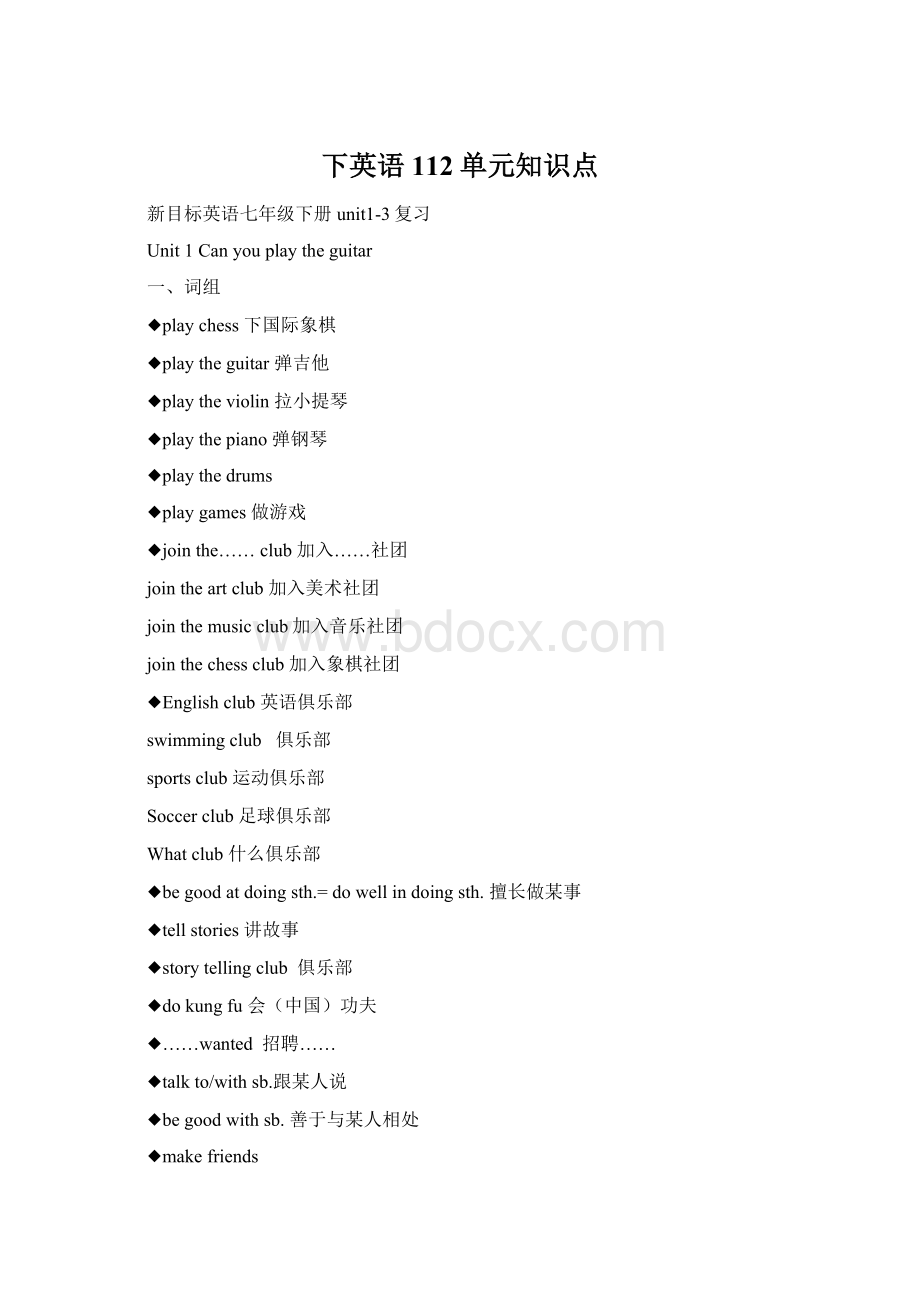下英语112单元知识点Word格式.docx
《下英语112单元知识点Word格式.docx》由会员分享,可在线阅读,更多相关《下英语112单元知识点Word格式.docx(30页珍藏版)》请在冰豆网上搜索。

◆4.Soundsgood.听起来不错。
◆wanttwogoodmusiciansforourrockband.
我们摇滚乐队想要两名音乐人(for表目的,用途:
为了)
◆6.IcanspeakEnglishandIcanalsoplaysoccer.
我能讲英语,也能踢足球。
◆7.PleasecallMrs.Millerat555-3721.
请打555-3721找米勒先生。
结构callsb.at……
Unit2Whattimedoyougotoschool
一、词组:
◆重点单词:
Whattime=whenfunny搞笑的
never从不always总是usually通常
then然后after在·
·
以后quarter四分之一
◆getup:
◆getdressed:
穿上衣服
◆go/gettoschool:
去上学
◆brushteeth:
刷牙齿
◆eat/havebreakfast/lunch/dinner吃早饭/午饭/晚饭
◆takeashower
◆gotobed:
上床睡觉
◆do(one’s)homework
◆lotsof=alotof大量
◆
half
past
six六点半
◆workataradiostation:
在广播台工作
◆radioshow电台节目
◆inthemorning/afternoon/evening在早上/下午/晚上
◆atnight在晚上
◆belatefor(school/work):
上学/上班迟到
◆cleanmyroom:
打扫我的房间
◆takeawalk:
◆havetimetodosth:
有时间做某事
◆either…or…或者…或者…;
要么…要么…
◆onweekends:
在周末=ontheweekend
◆(It)tastesgood:
尝起来味道好
◆haveaveryhealthylife.有个十分健康的生活
★1.o’clock的用法:
用在整点之后。
如sixo’clock
★2.时间的表达:
1)钟点的正读法:
先读小时,再读分钟;
如需区分上下午,可在时间后加或如:
4:
.读作fourthirty.
2)钟点的倒读法:
先读分钟,后读小时前
①分钟数≤30:
分钟数+past+小时数;
PS:
past是超过,晚于的意思如:
8:
14读作fourteenpasteight
②分钟数>
30:
(60-现在分钟数)+to+(现在小时+1)
PS:
to理解成“还有(几分钟)到(几点)”如:
8:
46读作fourteentonine
◆3.halfanhour半小时
halfpast……几点半……
◆4.quarter:
一刻钟;
四分之一。
一刻钟,即十五分钟
★5.词组辨析
(1).interested与interesting
★interested感兴趣;
对…感兴趣。
通常修饰“人“,通常用于:
be/get/feel/becomeinterestedin结构中
★interesting令人感兴趣的;
有趣的。
通常修饰“物”
(2).fun与funny区别:
★funny表示“有趣的,滑稽的”,侧重让人好玩或发笑。
★fun主要指“有趣,好玩”,不像funny那样强调“滑稽”。
havefun玩得开心
(3).gotobed和gotosleep区别:
★gotobed强调“上床睡觉”的动作,无“睡着”的意思。
★gotosleep强调“入睡;
睡着”,强调人已经“睡着”。
(4).whattime和when:
两者都对时间提问
★whattime所问的时间范围比较小,一般用来提问比较精确的时间,回答的时候一般用具体到几点。
★when所问的时间范围比较大,回答的时候可以用几点钟,也可以是上午或者下午,甚至是哪一天、哪一年。
三、句型:
◆1.-Whattimeisitnow现在几点了
-It’saboutsix-fourteen.大约六点十四分。
(对具体时刻提问:
whattime)
PS:
询问时间还可以用:
Whatisthetimenow/What'
stimenow/Doyouknowthetimenow
◆2.Whattimedoyouusuallygetup你通常何时起床
Iusuallygetupatsixthirty.
(在具体的时间点用介词at表示)
◆3.WhattimedoesRickeatbreakfastRick何时吃饭
Heeatsbreakfastatseveno’clock.
◆4.WhendoesScottgotoworkScott何时上班
◆5.Healwaysgoestoworkateleveno’clock.Heisneverlate.他总是11点去上班。
他从不迟到。
◆6.That’safunnytimeforbreakfast.那时吃早饭很滑稽。
◆7.Intheevening,IeitherwatchTVorplaycomputergames.在晚上,我要么看电视要么打电子游戏。
Unit3
How
do
you
get
to
school
1、重点短语
到校
take+交通工具
take
the
train
乘坐火车
bus
乘坐
subway
乘地铁
walk
步行去上学
◆rideabike=by
bike
骑
how
far多远
from
...to...
从......到......
◆howlong:
多久
Ittakes
sb.
some
time
sth.
花费某人时间去做……
◆driveacar:
开车
ride
乘汽车之行
haveagoodday.过的愉快
◆subwaystation:
◆crosstheriver:
过河
byboat
乘坐小船
◆between·
and·
:
在·
和·
之间
◆onaropeway.用索道
◆cometrue:
2、其他短语
home
从家到学校
every
day
每天
think
of
stop
公共汽车站
(临时)
busstation公共汽车站(总站)
play
with
…
和…玩
a
11-year-old
boy
一个11岁的男孩
◆leavethevillage离开村庄
★1.
take…
…=
go
by…
乘…去…
=onthe/a…
表示乘坐某种交通工具
如:
takethebustoschool=gotoschoolbybus=onthebus
★2.
/
does
…get
…是怎样到…的
★3.
far
is
it
从…到…有多远
(howfar对距离提问)
★4.
It
takes
花费某人时间去做……如Ittakesmeanhourtofinishmyhomework.完成家庭作业花了我一个小时的时间。
★5.
long
花费多长时间(howlong对时间的长短提问)
eg.:
Howlongdoesittakeyoutogotothesupermarket
★6.
+
adj.
做某事是….
forsb.+to
sth做某事对于某人来说是…
如:
Itiseasyformetoplaytheviolin.
拉小提琴对我来说很容易。
★7.
Thanks
for
n.
v.
ing感谢(做)某事。
Thanksforyourhelp.
◆1.
–
你怎么到校的
--
I
my
bike.我骑自行车。
◆2.
your
school
从你家到学校多远
◆3.
toschool
你到校用多长时间
◆4.
For
many
students,
easy
toschool.
对于很多学生来说,上学很容易。
◆5.
There
very
big
river
betweentheir
and
village.在学校和村庄之间有条大河
◆6.Theriverrunstooquicklyforboats.河水太急无法行船。
◆theirdreamcometrue他们的梦想能实现吗
Unit4Don’teatinclass.
1、重点单词
rule规则important重要的outside外面
dininghall餐厅noisy吵闹的before在…前
2、短语:
◆inclass在课堂上intheclassroom在班里
◆arrivelateforclass=belateforclass上课迟到
◆beontime
◆inthehallways在走廊里,在过道
◆Listentomusic:
◆Don’t+动词原形.不要……
Don’trun不要跑
Don’tfight.不要打架
◆fightwithsb.和某人打架
◆wearahat
◆myfirstdayatschool在学校的第一天
◆musicplayer音乐播放器
◆be/keepquiet保持安静
◆weartheschooluniform穿校服
一些
◆Isee.我知道,我了解
goout外出(娱乐)
◆dothedishes:
◆makeone’sbed:
铺床
practicetheguitar练习吉他
dothedishes清洗餐具
◆toomanyrules规章制度
followtherules规章制度
afterschool放学后
goodluck:
祝你好运
makerules制定规章制度
breaktherules违反规章制度
◆makedinner/breakfast做饭/早饭
onschoolnights学校住宿的夜间
take…forawalk带领…散步
★祈使句
通常用来表示命令、请求、禁止、建议、警告等语气。
它的主语you(听话人)常省略。
其构成有以下几种形式。
1)Be型
肯定:
系动词be+表语+其他。
Bequiet,please.请安静
否定:
Don’t+be+表语+其他。
Don’tbenoisy.不要吵闹
2)Do型
动词原形+宾语+其他。
Openthedoor.开门
Don’t+动词原形+宾语+其他。
Don’tfight.不要打架
3)Let型
Let+宾语+动词原形+其他,如:
Letmehelpyou.让我帮你。
Let’sgoatsixo’clock.让我们六点去。
一般在宾语后加not。
Let’snotwatchTV.我们别看电视了。
4)No+V-ing型
此种形式通常用于公共场合的提示语中,意为“禁止做某事“如:
Nosmoking!
严禁吸烟!
Notalking!
不许交谈!
Nopassing!
禁止通行!
Noparking!
不许停车
★Youcan’t…和Don’t…的转化
Youcan’tbelate.=Don’tbelate.
arrivein/at到达(后接地点)
practice(doing)sth.练习(做)某事
◆bring…to…把……带来……
★
haveto不得不[情态动词,接动词原形]
情态动词must,haveto两者都有“必须”的意思
haveto:
表示客观需要,即周围的环境、习惯等要求某人不得不或必须去干某事
其他形式:
hasto;
don’t/doesn’thaveto
must:
表示说话人的主观看法,即主观上必要性,还用来命令或叮嘱。
(否定用needn’t)
bestrictwithsb.(insth.)(在某方面)对某人严格
Hermotherisverystrict_________her.
★Iknowhowyoufeel.我知道你感受如何。
从句用陈述语序
(1)Don’truninthehallways.不要在走廊里跑。
(2)Whataretherules规则是什么
(3)–Doeshehavetowearauniformatschool
-Yes,hedoes/No,hedoesn’t.
(4)--Canwewearhatsinclass我们在课上能戴帽子么
--Yes,wecan/No,wecan’t.
(5)Don’tleavethedirtydishesinthekitchen.
不要把脏盘子留在厨房
Unit5Whydoyoulikepandas
1、描述性的形容词:
interesting/fun有趣的smart/clever聪明的scary可怕的ugly难看的beautiful美丽的cute/lovely可爱的friendly友好的quiet安静的shy害羞的lazy懒惰的
2.动物animals:
cat猫tiger老虎elephant大象koala考拉
Lion狮子giraffe长颈鹿panda熊猫
3、重点短语
◆kindof有点儿(修饰形容词、动词)
◆Let’ssee……(let’s=letus)让我们去看看……
◆befriendlyto对…友好
◆befrom=comefrom
◆walkontwolegs.用两条腿走路
◆sleepallday整天睡觉
◆whatanimals什么动物
◆bein(great)danger
◆oneof………之一
◆savetheelephants拯救大象
◆getlost迷路
◆cutdownmanytrees.
◆losetheirhomes.丢失他们的家园
◆killelephantsfortheirivory杀死大象为了象牙
◆(be)madeof由……制造
◆asymbolofgoodluck
◆Letsbdosth让某人做某事,如Let’sgo.
◆Why句型:
1)肯定:
Why+一般疑问句,如
Whydoyoulikepandas你为什么喜欢熊猫
2)否定:
Why+don’t+其他
Whydon’tyouliketigers你为什么不喜欢老虎
★答语用because……
(1)-Whydoyoulikepandas你为什么喜欢熊猫
-Becausethey’reverycute.
(2)-Whydosehelikekoalas他为什么喜欢考拉
-Becausetheyarekindofinteresting.
(3)-Whydon’tyouliketigers你为什么不喜欢老虎
-Becausetheyarereallyscary.
(4)-Wherearelionsfrom狮子来自哪里
-TheyarefromSouthAfrica.他们来自南非。
(5)-Whatanimalsdoyoulike你喜欢什么动物
-Ilikeelephants.
四、日常交际用语
(1)-Let’sseethelionsfirst.(first首先,可置于句首\句末)
(2)-Whydoyouwanttoseethelions为么你想看狮子
-Becausetheyareverycute.
(3)-Doyoulikegiraffes-Yes,Ido./No,Idon’t
你喜欢长颈鹿么
Unit6I’mwatchingTV.
1.重点单词:
delicious美味的American美国的
Just恰好now现在tomorrow明天miss思念
drink喝study学习child儿童(children复数)
any任何的;
任一的other其它的Wish希望
2.词组
◆watchTV看电视
◆readanewspaper读报纸
◆talkonthephone
◆listentoaCD听CD
◆usethecomputer使用电脑
◆makesoup/zongzi做汤/粽子
◆washthedishes=dothedishes洗碗
◆gotothemovies去看电影=seeafilm=gotocinema
◆Notmuch.没有什么。
◆washone’sclothes洗衣服
◆eatout出去吃
◆meetatmyhome
◆seeyouthen到时见
◆talkabout谈论
◆inthetree在树上(树外之物)
◆onthetree在树上(树上长出来的)
◆drinktea
◆dosomecleaning/reading做清洁/阅读
◆intheUnitedStates=intheUS在美国
◆DragonBoatFestival:
端午节
◆livewithsb.和……住在一起
◆boatraces
◆anyothernight任何其他夜晚
◆hostfamily寄住家庭
◆missone’sfamily想念家人
◆wishtodosth希望做某事
★1.现在进行时
1)现在在进行时的形式是:
助动词be(am,is,are)+动词-ing形式(也叫现在分词),
表示现在(说话的瞬间)正在进行或发生的动作。
2)肯定:
主语+be(am,is,are)+动词现在分词+其他
I’mwatchingTV.
3)否定:
主语+be(am,is,are)+not+动词现在分词+其他
Theyarenotplayingsoccer.
4)一般疑问句形式:
Is(am,are)+主语+动词现在分词+其他
回答:
Yes,主语+is/am/are.No,主语+isn’t/aren’